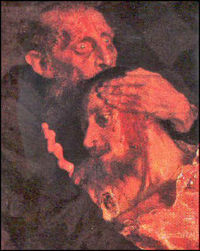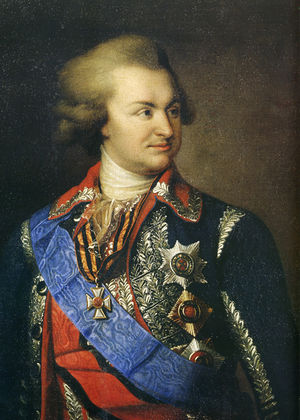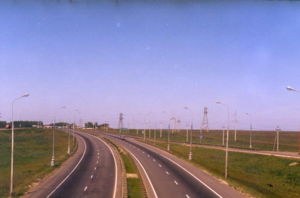History of Russia
This article covers the History of Russia from 862 AD to the present. For current conditions see Russia.
Contents
Kievan Rus
Although human experience on the territory of present-day Russia dates back to Paleolithic times, the first lineal predecessor of the modern Russian state was founded in 862. The political entity known as Kievan Rus was established in Kiev in 962 and lasted until the 12th century. In the 10th century, Christianity became the state religion under Vladimir, who adopted Greek Orthodox rites. Consequently, Byzantine culture predominated, as is evident in much of Russia's architectural, musical, and artistic heritage. Over the next centuries, various invaders assaulted the Kievan state and, finally, Mongols under Batu Khan destroyed the main population centers except for Novgorod and Pskov in the 13th century and prevailed over the region until 1480. Some historians believe that the Mongol period had a lasting impact on Russian political culture.
Muscovy
In the post-Mongol period, 'Muscovy gradually became the dominant principality and was able, through diplomacy and conquest, to establish suzerainty over European Russia. Ivan III (1462-1505) referred to his empire as "the Third Rome" and considered it heir to the Byzantine tradition. Ivan IV (the Terrible) (1530-1584) was the first Russian ruler to call himself tsar. He pushed Russian eastward with his conquests but his later reign was marked by the cruelty that earned him his familiar epithet. He was succeeded by his feeble son, the childless Feodor I Ivanovich who reigned from 1584-1598. Boris Godunov,the brother-in-law of Feodor, became the tsar Boris I. He ruled from 1598-1604 when he was disposed and killed, along with this wife and son, by a cabal of boyar. With the death of Boris I Russia commenced the so-called Time of Troubles which was to see further brief and bloody reigns. In 1613, after relative stability was achieved, fifteen year old Michael Romanov was selected by an assembled council of lay and ecclesiastical to be the new tsar. The dynasty that bore his name survived until 1917 with the death of Nichols II and his family.
Peter the Grat and Modernization
During the reign of Peter the Great (1689-1725), modernization and European influences spread in Russia. Peter created Western-style military forces, subordinated the Russian Orthodox Church hierarchy to the tsar, reformed the entire governmental structure, and established the beginnings of a Western-style education system. He moved the capital westward from Moscow to St. Petersburg, his newly established city on the Baltic. His introduction of European customs generated nationalistic resentments in society and spawned the philosophical rivalry between "Westernizers" and nationalistic "Slavophiles" that remains a key dynamic of current Russian social and political thought.
Catherine the Great continued Peter's expansionist policies and established Russia as a European power. During her reign (1762–96), power was centralized in the monarchy, and administrative reforms concentrated great wealth and privilege in the hands of the Russian nobility. Catherine was also known as an enthusiastic patron of art, literature and education and for her correspondence with Voltaire and other Enlightenment figures. Catherine also engaged in a territorial resettlement of Jews into what became known as "The Pale of Settlement," where great numbers of Jews were concentrated and later subject to vicious attacks known as pogroms.
19th Century
Alexander I (1801-1825) began his reign as a reformer, but after defeating Napoleon's 1812 attempt to conquer Russia, he became much more conservative and rolled back many of his early reforms. During this era, Russia gained control of Georgia and much of the Caucasus. Throughout the 19th century, the Russian Government sought to suppress repeated attempts at reform and attempts at liberation by various national movements, particularly under the reign of Nicholas I (1825-1855). Its economy failed to compete with those of Western countries. Russian cities were growing without an industrial base to generate employment, although emancipation of the serfs in 1861 foreshadowed urbanization and rapid industrialization late in the century. At the same time, Russia expanded into the rest of the Caucasus, Central Asia and across Siberia. The port of Vladivostok was opened on the Pacific coast in 1860. The Trans-Siberian Railroad opened vast frontiers to development late in the century. In the 19th century, Russian culture flourished as Russian artists made significant contributions to world literature, visual arts, dance, and music. The names of Dostoyevsky, Tolstoy, Gogal, Repin, and Tchaikovsky became known to the world.
Alexander II (1855-1881), a relatively liberal tsar, emancipated the serfs. His 1881 assassination, however, prompted the reactionary rule of Alexander III (1881-1894).
1900-1917
By 1900, imperial decline became evident. Russia was defeated in the unpopular Russo-Japanese War in 1905. The Russian Revolution of 1905 forced Tsar Nicholas II (1894-1917) to grant a constitution and introduce limited democratic reforms. The government suppressed opposition and manipulated popular anger into anti-Semitic pogroms. Attempts at economic change, such as land reform, were incomplete.
1917 Revolution and the U.S.S.R.
The ruinous effects of World War I, combined with internal pressures, sparked the March 1917 uprising that led Tsar Nicholas II to abdicate the throne. A provisional government came to power, headed by Aleksandr Kerenskiy. On November 7, 1917, the Bolshevik Party, led by Vladimir Lenin, seized control and established the Russian Soviet Federated Socialist Republic. Civil war broke out in 1918 between Lenin's "Red" army and various "White" forces and lasted until 1920, when, despite foreign interventions and an unsuccessful war with Poland, the Bolsheviks triumphed. After the Red army conquered Ukraine, Belarus, Azerbaijan, Georgia, and Armenia, a new nation, the Union of Soviet Socialist Republics (U.S.S.R.), was formed in 1922.
First among its political figures was Lenin, leader of the Bolshevik Party and head of the first Soviet Government, who died in 1924.
Stalin
In the late 1920s, Josef Stalin emerged as General Secretary of the Communist Party of the Soviet Union (CPSU) amidst intra-party rivalries; he maintained complete control over Soviet domestic and international policy until his death in 1953. In the 1930s, Stalin oversaw the forced collectivization of tens of millions of its citizens in state agricultural and industrial enterprises. Millions died in the process. Millions more died in political purges, the vast penal and labor system, and in state-created famines. Initially allied to Nazi Germany, which resulted in significant territorial additions on its western border, the U.S.S.R. was attacked by the Axis on June 22, 1941. Twenty million Soviet citizens died during World War II in the successful effort to defeat the Axis, in addition to over two million Soviet Jews who perished in the Holocaust. After the war, the U.S.S.R. became one of the Permanent Members of the UN Security Council. In 1949, the U.S.S.R. developed its own nuclear arsenal.
After Stalin
Khrushchev
Stalin's successor, Nikita Khrushchev, served as Communist Party leader until he was ousted over controversies involving the recklessness of the Cuban missile crisis and allowing the publication of Alexander Solzhenitsyn's Day in the Life of Ivan Denisovich with its Christian theme in Leftist totalitarian state.
Brezhnev
Aleksey Kosygin became Chairman of the Council of Ministers, and Leonid Brezhnev was made First Secretary of the CPSU Central Committee in 1964. In 1971, Brezhnev rose to become "first among equals" in a collective leadership. Brezhnev died in 1982 and was succeeded by Yuri Andropov (1982–84) and Konstantin Chernenko (1984-85).
Gorbachev and the fall of Communism
In 1985, Mikhail Gorbachev became the next (and last) General Secretary of the CPSU. Gorbachev introduced policies of perestroika (restructuring) and glasnost (openness). But his efforts to reform the creaky Communist system from within failed. The people of the Soviet Union were not content with half-freedoms granted by Moscow; they demanded more and the system collapsed. Boris Yeltsin was elected the first president of the Russian Federation in 1991. Russia, Ukraine and Belarus formed the Commonwealth of Independent States in December 1991. Gorbachev resigned as Soviet President on December 25, 1991. Eleven days later, the U.S.S.R. was formally dissolved.
The Russian Federation
After the December 1991 dissolution of the Soviet Union, the Russian Federation became its successor state, inheriting its permanent seat on the UN Security Council, as well as the bulk of its foreign assets and debt. By the fall of 1993, politics in Russia reached a stalemate between President Yeltsin and the parliament. The parliament had succeeded in blocking, overturning, or ignoring the President's initiatives on drafting a new constitution, conducting new elections, and making further progress on democratic and economic reforms.
In a dramatic speech in September 1993, President Yeltsin dissolved the Russian parliament and called for new national elections and a new constitution. The standoff between the executive branch and opponents in the legislature turned violent in October after supporters of the parliament tried to instigate an armed insurrection. Yeltsin ordered the army to respond with force to capture the parliament building and crush the insurrection. In December 1993, voters elected a new parliament and approved a new constitution that had been drafted by the Yeltsin government. Yeltsin remained the dominant political figure, although a broad array of parties, including ultra-nationalists, liberals, agrarians, and communists, had substantial representation in the parliament and competed actively in elections at all levels of government.
Chechnya
In late 1994, the Russian security forces launched a military operation in the Republic of Chechnya against Islamists who were intent on separation from Russia. The protracted conflict, which received close scrutiny in the Russian media, raised serious human rights and humanitarian concerns abroad as well as within Russia. After numerous unsuccessful attempts to institute a cease-fire, in August 1996 the Russian and Chechen authorities negotiated a settlement that resulted in a complete withdrawal of Russian troops and the holding of elections in January 1997. A peace treaty was concluded in May 1997. Following a number of terrorist incidents from Chechen separatists, the Russian government launched a new military campaign into Chechnya. By spring 2000, federal forces claimed control over Chechen territory, but fighting continues as rebel fighters regularly ambush Russian forces in the region. Throughout 2002 and 2003, the ability of Chechen separatists to battle the Russian forces waned but they claimed responsibility for numerous terrorist acts. In 2005 and 2006, key separatist leaders were killed by Russian forces.
Putin
On December 31, 1999 Boris Yeltsin resigned, and Vladimir Putin was named Acting President. In March 2000, he won election in his own right as Russia's second president with 53% of the vote. Putin moved quickly to reassert Moscow's control over the regions, whose governors had confidently ignored edicts from Boris Yeltsin. He sent his own "plenipotentiary representatives" (commonly called ‘polpred' in Russian) to ensure that Moscow's policies were followed in recalcitrant regions and republics. He won enactment of liberal economic reforms that rescued a faltering economy and stopped a spiral of hyperinflation. Putin achieved wide popularity by stabilizing the government, especially in marked contrast to what many Russians saw as the chaos of the latter Yeltsin years. The economy grew, both because of rising oil prices and in part because Putin was able to achieve reforms in banking, labor, and private property. During this time, Russia also moved closer to the U.S., especially after the terror attacks of September 11, 2001. In 2002, the NATO-Russia Council was established, giving Russia a voice in NATO discussions.
Further reading
- Channon, John. The Penguin Historical Atlas of Russia (1995).
- Riasanovsky, Nicholas V. and Steinberg, Mark. A History of Russia (2004), latest version of the best survey excerpt and text search
- Service, Robert. A History of Modern Russia: From Nicholas II to Vladimir Putin (2005)
- Westwood, J. N. Endurance and Endeavour: Russian History, 1812-1992 (1993) online edition
- Ziegler, Charles E. The History of Russia (1999) 250 pp. online edition
Specialized bibliography
- Freeze, Gregory,ed. Russia: A History (1997), essays by British and American scholars.
- Kaiser, Daniel H., Gary Marker, eds. Reinterpreting Russian History: Readings, 860-1860s (1994) online edition, essays by scholars
Subjects: Russia—Historiography, Russia—History—Sources
Medieval to 1613
- Crummey, Robert O. The Formation of Muscovy, 1304- 1613 (1987)
- Martin, Janet. Medieval Russia 980-1584 (1995), advanced
Tsarist: 1613-1917
- Alexander, John T. Catherine the Great: Life and Legend (1989),
- Lincoln, W. Bruce. The Romanovs: Autocrats of All the Russias (1981), Tsars from 1613 to 1917
- Lincoln, W. Bruce. In War's Dark Shadow: The Russians Before the Great War (1983), 1890 to 1914
- Massey, Robert O. Peter the Great (1992)
Soviet Era 1918-1991
- Brzezinski, Zbigniew. Grand Failure: The Birth and Death of Communism in the Twentieth Century (1990)
- Ingram, Philip. Russia and the USSR, 1905-1991 (1997) excerpt and text search
- Keep, John L. H. Last of the Empires: A History of the Soviet Union, 1945-1991 (1996) online edition
- McCauley, Martin. The Soviet Union: 1917-1991 (1993) online edition
- McCauley, Martin. Who's Who in Russia since 1900, (1997) online edition
- Malia, Martin. Soviet Tragedy: A History of Socialism in Russia (1995) excerpt and text search
- Nove, Alec. An Economic History of the USSR 1917-1991 (3rd ed. 1993)
- Pipes, Richard. Communism: A History (2003), by a leading conservative
- Pipes, Richard. The Russian Revolution (1990), in-depth histgory by conservative scholar
- Suny, Ronald Grigor. The Soviet Experiment: Russia, the USSR, and the Successor States. (1998) online edition
Lenin and Stalin
- Bullock, Alan. Hitler and Stalin: Parallel Lives (1992), a double biography covering each man in separate but parallel chapters
- Lee, Stephen J. Stalin and the Soviet Union (1999) online edition
- McCauley, Martin. Stalin and Stalinism (3rd ed 2003), 172pp
- Service, Robert. Stalin: A Biography (2004), along with Tucker the standard biography
- Service, Robert. Lenin: A Biography (2002)
- Tucker, Robert C. Stalin as Revolutionary, 1879-1929 (1973); Stalin in Power: The Revolution from Above, 1929-1941. (1990) online edition with Service, a standard biography; online at ACLS e-books
- Ulam, A. B. Stalin (1973), good older biography; replaced by Tucker and Service
- Wood, Alan. Stalin and Stalinism, (2004), 105pp online edition
Peoples, society, culture
- Cole, J. P. Geography of the Soviet Union (1984) online edition
- Davis, Nathaniel. A Long Walk to Church: A Contemporary History of Russian Orthodoxy (1995) online edition
- Denber, Rachel. The Soviet Nationality Reader: The Disintegration in Context (1992) online edition
- Lane, David. Soviet Society under Perestroika (1992) online edition
- Lapidus, Gail Warshofsky. Women, Work, and Family in the Soviet Union (1982) online edition
- Lutz, Wolfgang Lutz, Sergei Scherbov, Andrei Volkov. Demographic Trends and Patterns in the Soviet Union before 1991 (1994) online edition
- Wixman, Ronald. The Peoples of the USSR: An Ethnographic Handbook (1984) online edition
1918-1939
- Daniels, R. V., ed. The Stalin Revolution (1965)
- Davies, Sarah, and James Harris, eds. Stalin: A New History, (2006), 310pp, 14 specialized essays by scholars excerpt and text search
- De Jonge, Alex. Stalin and the Shaping of the Soviet Union (1986)
- Fitzpatrick, Sheila, ed. Stalinism: New Directions, (1999), 396pp excerpts from many scholars on the impact of Stalinism on the people (little on Stalin himself) online edition
- Hoffmann, David L. ed. Stalinism: The Essential Readings, (2002) essays by 12 scholars
- Pipes, Richard. A Concise History of the Russian Revolution (1996) excerpt and text search, by a leading conservative
- Tucker, Robert. Stalinism: Essays in Historical Interpretation (1998) excerpt and text search
Gulag and Terror
- Applebaum, Anne. Gulag: A History. 2003. 736 pp. excerpt and text search
- Conquest, Robert. The Great Terror: A Reassessment (1991) online edition
- Pohl, J. Otto. Ethnic Cleansing in the USSR, 1937-1949 (1999) online edition
- Rosefielde, Steven. "Stalinism in Post-Communist Perspective: New Evidence on Killings, Forced Labour and Economic Growth in the 1930s" Europe-Asia Studies, Vol. 48, No. 6 (Sep., 1996), pp. 959–987 in JSTOR
World War II
- Broekmeyer, Marius. Stalin, the Russians, and Their War, 1941-1945. 2004. 315 pp.
- Overy, Richard. The Dictators: Hitler's Germany and Stalin's Russia. 2004. 448 pp. focus on 1930-45 excerpt and text search
- Priestland, David. Stalinism and the Politics of Mobilization (2007) excerpt and text search
- Roberts, Geoffrey. Stalin's Wars: From World War to Cold War, 1939–1953 (2006).
Cold War
- see Cold War
- Craig, Campbell, and Yuri Smirnov. Truman, Stalin, and the Bomb (2008)
- Gaddis, John. A New History of the Cold War (2006)
- Holloway, David. Stalin and the Bomb: The Soviet Union and Atomic Energy, 1939-1956 (1996) excerpt and text search
- Mastny, Vojtech. The Cold War and Soviet Insecurity: The Stalin Years (1998) online edition online at ACLS e-books
- Zubok, Vladislav M. A Failed Empire: The Soviet Union in the Cold War from Stalin to Gorbachev (2007) excerpt and text search
Khruschev, Gorbachev
- Brown, Archie. The Gorbachev Factor (1996) online edition
- Dallin, Alexander, and Gail W. Lapidus. The Soviet System: From Crisis to Collapse (1995) online edition
- Matlock, Jack. Reagan and Gorbachev: How the Cold War Ended (2005), by leading conservative excerpt and text search
- Taubman, William. Khrushchev: The Man and His Era (2004) excerpt and text search
- Zubok, Vladislav M. A Failed Empire: The Soviet Union in the Cold War from Stalin to Gorbachev (2007) excerpt and text search




